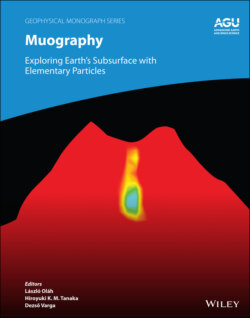Читать книгу Muography - Группа авторов - Страница 20
1.2.5 Muon Flux Reduction through Matter
ОглавлениеDuring the ionization process, muons frequently collide with electrons, losing a very small fraction of their energy in each collision. If the energy loss of muons in matter were only due to ionization, muons of a given energy would have an almost unique range because the number of such encounters is proportional to the densimetric length they traverse. However, for high‐energy muons, the radiative processes become more predominant, and at the same time, fluctuations within the range are enhanced by the radiative processes, namely bremsstrahlung, direct pair production, and photonuclear interactions. In these processes, muons lose a large but random fraction of their energy. For high‐energy muons (> 1 TeV), the contribution of the ionization process is small compared with the other three processes. For example, the radiative process dominates above 708 GeV in SiO2 (Groom et al., 2001).
The muon's energy loss rate depends on materials. The electrons have a tendency to be more concentrated per unit mass in lighter materials, and thus muons lose more energy in lighter materials through the ionization process. However, larger nuclei increase the possibilities of radiative processes occurring and thus, high‐energy muons lose more energy in heavier materials. For example, the 1‐GeV muon's range is 550 g/cm2 in SiO2 but muons with the same energy can penetrate only 470 g/cm2 of water (Groom et al., 2001). On the contrary, while 10‐TeV muons can penetrate 6,900 hg/cm2 in SiO2, they can penetrate 7,800 hg/cm2 in water (Groom et al., 2001).
For the calculation of the analytical range of high‐energy muons, the energy loss relationship presented by Adair and Kasha (1977) is convenient:
(1.1)
where E is the muon energy, x is the densimetric thickness (path length times average density along the muon path) along the path traversed by the muon, k(E) is the ionization energy loss, and b(E)E is the sum of the energy losses via three stochastic processes. The values for k(E) and b(E)E can be found at the reference for various materials (Groom et al. 2001). By integrating equation 1.1 over the energy range between 0 and the muon’s incident energy, the continuous slowing down approximation (CSDA) range of the muon can be calculated.
Since the range is a function of the incident muon energy, it can be incorporated in the open‐sky muon spectrum. Once both the muon path length and the average density along the path are known, the densimetric thickness (x) can be calculated by multiplying them, and thus the minimum energy (E c) of muons that can penetrate through a material with this thickness can be determined using equation 1.1. By integrating the open‐sky spectrum I (E, θ) from E c to infinity, we obtain the integrated muon intensity N(E c,), which represents the number of muons that have enough energy to escape from the target of interest:
(1.2)
where I(E,θ) is the zenith‐angle‐dependent open‐sky muon energy spectrum. The integrated muon intensities calculated with equation 1.2 are shown for various near‐horizontal angles in Fig. 1.1.
